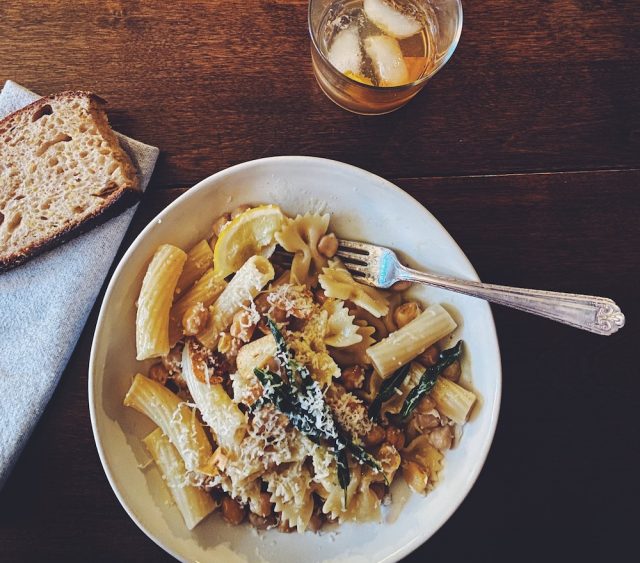Weeknight Pasta with Chickpeas {Pasta e Ceci}

{recipe: pasta e ceci}
Fall is finally here, at least according to the calendar. Am I the only one who felt this summer was never-ending, and not in a good way? Perhaps it’s because we had a lot of family changes happening. I knew it would be right around this time that things might find a new groove to settle into. Isabella is adjusting to college life (I think), and I guess I’m adjusting to the fact that she’s adjusting to college life (I think). Virginia is getting used to her new school, as well.
These last few months of the year have always been my favorite. I love the way rhythms begin to slow down. Much as I miss daylight, slowly being stolen by later sun rises and earlier sunsets, it’s also a natural cue to slow down, providing more opportunities for mental hibernation.
Last week was Yom Kippur, and while many people focus on the fast as an arduous task, I find so much clarity and beauty in it. The combination of fasting and refraining from technology for the day leaves me with a lighter, freer feeling.
I hadn’t given too much thought to my last meal before beginning my fast and logging on for services but I had been diligent about drinking a ton of water in the days leading up to it, so I wasn’t too worried about not having a proper meal planned. I’d worked later than expected, and was pressed for time but also had the idea of making pasta tucked in the back of my mind all day.
When it was time to step away from my work laptop, I scampered into the kitchen and surveyed what pasta was in need of finishing up. Michael used to get so annoyed when I mixed pasta shapes, and so does Bella, but with neither of them there, and Virginia being amenable to the idea, I settled on a mix of farfalle and rigatoni. It goes without saying, should you mix pasta shapes, be sure they’re of similar sizes so they cook evenly.
I put up a pot of water to boil, and then scanned the fridge to see what I could scrape together to add to the pasta besides the usual tomato sauce. Thankfully, my past self had thawed a jar of homemade chickpeas a few days prior, and a firmer plan for dinner began to take shape: pasta e ceci.
Ditalini, a smaller-shaped pasta, closer to the size of chickpeas is often used but the great thing about cooking for yourself is you can do what you want. I liked knowing some of the chickpeas might get trapped inside the rigatoni’s tube-like structure, too.
What follows is less a firm recipe, and more an idea. This is very much how I cook at home in my free time when not writing more precise recipes for my new site (in case you’re wondering where I’ve been).
Be well, and as always, be kind. xo-j
Click here to visit my new site for brand new recipes!
p.s. Before moving onto my no-recipe recipe for pasta e ceci, I wanted to share some links to a few favorite fall recipes.
 Sourdough English Muffins
Sourdough English Muffins Pasta e Ceci
serves as many as you need
What You’ll Need:
pasta
garlic
olive oil
fresh sage leaves
chickpeas, along with their cooking liquid (or some broth)
lemon
pecorino locatelli
Begin by boiling a pot of water. Once boiling, generously salt your water, add the desired amount of pasta, bring the water back to a boil and cook until pasta is very al dente (you’re going to finish cooking it in the pan with the chickpeas). Reserve some of the cooking water before draining the pasta (I usually reserve 1/2 cup per 2 oz dry pasta added). You might not need it all but better to have extra than run short at the end.
While the water boils and pasta cooks, thinly slice a few garlic cloves, using an amount that suits your tastes.
In a skillet large enough to hold the amount of pasta you’re cooking, swirl in an 1/8-inch of oil, then heat the oil over medium-high until shimmering. Meanwhile, line a plate with a paper towel.
Add the garlic slices to the oil, and cook until deep golden and crisp, tilting the pan to allow the garlic to cook evenly. This part will go fast, so keep a close eye, and transfer the garlic to the lined plate to drain.
With the skillet still over the flame, add the sage leaves, cooking until frizzled and crisp—the oil will pop, so be mindful of splatters. Transfer the fried sage leaves to the plate with the garlic to drain.
Return the skillet with the oil to medium heat and add the chickpeas—use as much as you’d like, again keeping in mind the oil will sputter furiously. Stir in some of the bean broth from the chickpeas* (see note), as much as you like depending on whether you prefer a thin soupy sauce or something that’ll cling to the pasta. Cut the lemon, squeeze it in, then toss the crumpled lemon rinds in the pan, along with some butter—again you can be the judge here on how much you want.
Season the sauce with salt and freshly ground black pepper—chili flakes are a nice touch, too, if desired. Add the cooked pasta and some of the reserved cooking water, as desired, stirring to coat, then reduce heat to low and simmer until pasta is just done, 1 to 2 minutes is all it’ll need.
Spoon the pasta, chickpeas and any sauce into bowls then serve topped with some grated pecorino, the crispy garlic and fried sage leaves.
*NOTE: I store my homemade beans in their own broth, and use that as the base for soups and sauce. If using storebought, canned chickpeas (they work absolutely fine here), drain and rinse the chickpeas before adding to the skillet. Substitute vegetable or chicken broth for the bean broth.
